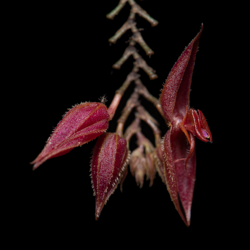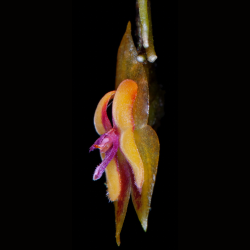Supervisor
Professor David Edwards
Brief summary
Orchids are the most biodiverse and enigmatic plant group, yet face major conservation threats through habitat loss and climate change. Concurrently, there is an increasing global focus on large-scale restoration via natural regeneration to cost-effectively return carbon stocks to landscapes, with evidence suggesting that this will also recover faunal diversity. A key question is whether naturally regenerating forests also recover orchids across space and time, given they are often range-restricted, dispersal limited, and have specific microclimatic requirements and mycorrhizal associations, or whether losses from deforestation are more permanent. This PhD project will quantify how natural regeneration across time, connectivity, altitudes, and ecoregions impacts orchid recovery for localized-endemic to large-ranged orchid species. It will use a combination of extensive field data collection, species occupancy modelling, distribution modelling of species ranges, and mapped upscaling to identify hotspots of restoration potential. We expect this PhD project to make discoveries of new orchid species to science, resulting in their formal description.
Project Summary
Orchids are the most biodiverse and enigmatic plant group, yet face major conservation threats through habitat loss and climate change. Concurrently, there is an increasing global focus on large-scale restoration via natural regeneration to cost-effectively return carbon stocks to landscapes, with evidence suggesting that this will also recover faunal diversity. A key question is whether secondary forests also recover orchids across space and time, given they are often range-restricted, dispersal limited, and have specific microclimatic requirements and mycorrhizal associations.
Our work has focused on the tropical Andes as the global epicentre of orchid diversity. We have revealed that orchid abundance and species richness are negatively impacted by deforestation, especially at mid-elevations (~2200 m asl), and that there are important roles of geographic distance in mediating patterns of orchid species response to land-use change. The problem is that we lack understanding about whether natural regeneration in the tropical Andes can rapidly return orchid diversity or whether losses from deforestation are more permanent. This PhD will fill this urgent research gap to provide a critical evidence base on the potential benefits of secondary forests across space and time in meeting conservation goals for Andean orchids.
Specifically, this PhD project will quantify how natural regeneration across time, connectivity, altitudes, and ecoregions impacts orchid recovery. It will use a combination of extensive field data collection, combined with new species distribution maps, to quantify outcomes for localized-endemic to large-ranged orchid species. During our research, we have thus far discovered 18 new orchid species to science (see example photos) and expect this PhD project to make further discoveries. The successful applicant will join the Centre for Global Wood Security which is directed by Edwards, and will be embedded within the Cambridge Conservation Initiative housed in the David Attenborough building.
What will the successful applicant do?
- Receive training in orchid taxonomy and sampling
- Conduct fieldwork across the Colombian Andes in secondary forests, and pasture and primary forest controls, with support from our strong network of within-country collaborations.
- Build models that link orchid species occupancy to restoration age, habitat connectivity, altitude, and ecoregion
- Feed into distribution modelling of species ranges
- Upscale findings to identify hotspots that maximise the benefits of secondary forest restoration for orchids
- Assist in formal taxonomic descriptions of any new species discovered to science
References
Gilroy JJ, Woodcock P, Edwards FA, Wheeler CE, Baptiste BLG, Medina CA, Haugaasen T, Edwards DP (2014) Cheap carbon and biodiversity co-benefits from forest regeneration in a hotspot of endemism. Nature Climate Change 4: 503-507. doi.org/10.1038/nclimate2200
Hua F, Bruijnzeel LA, Meli P, Martin PA, McEvoy C, Zhang J, Pena Arancibia JL, Brancalion PHS, Smith P, Edwards DP, Balmford A (2022) The ecosystem service and biodiversity benefits of restoration. Science 376: 839-844. DOI: 10.1126/science.abl4649
Parra-Sanchez E, Edwards DP (2024) Spatial extent predicts Andean epiphyte biodiversity responses to habitat loss and fragmentation across human-modified landscapes. Journal of Biogeography in press. doi.org/10.1111/jbi.14819
Parra-Sanchez E, Freckleton RP, Hethcoat MG, Ochoa-Quintero JM, Edwards DP (2024) Transformation of natural habitat disrupts biogeographical patterns of orchid diversity. Biological Conservation 292: 110538. doi.org/10.1016/j.biocon.2024.110538
Parra-Sanchez E, Perez-Escobar O, Edwards DP (2023) Neutral-based overrule niche-based processes in shaping tropical montane orchid communities across spatial scales. Journal of Ecology 111: 1614-1628. doi.org/10.1111/1365-2745.14140
Parra-Sanchez E, Restrepo E, Barrera Y, Ordonez-Blanco C, Edwards DP (2024) Lepanthes chalalensis (Pleurothallindinae), a new species endemic to the Santander Department in Colombia. Lankesteriana 24:131-140. doi.org/10.15517/lank.v24i2.56321


